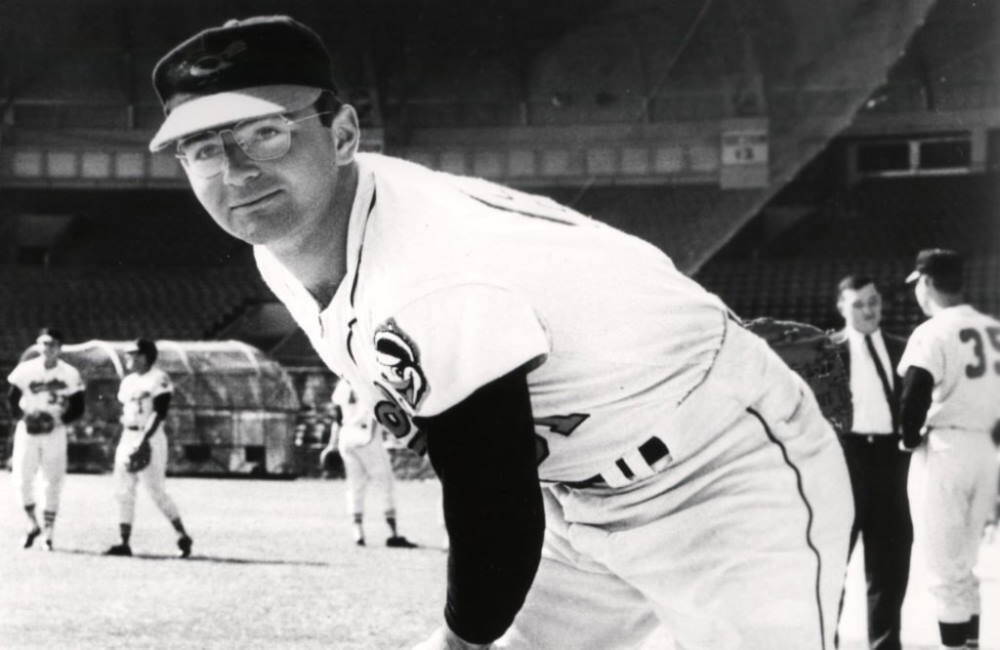Steve Dalkowski, one of the greatest pitchers who never was in Major League Baseball, died in 2020 from the complications involving the coronavirus. It brought an end to a life known for incredible potential never realized because of a series of on-field and off-field issues.
The Dalkowski story is one of those that most true baseball fans know well. It’s become so legendary that some people have stopped believing it. But there are still plenty of people around to set the record straight. One of those is Davey Johnson, who either played against or managed some of the greatest pitchers of the last 60-plus years.
“Steve Dalkowski threw harder than anybody I ever saw,” Johnson told the Washington Post. “He even threw his slider 95 miles per hour.”
Who was this man people still speak of as a legend, even though he never pitched in the majors? His story is one of great potential and great tragedy.
Biggest Scandals in Baseball History
Steve Dalkowski’s Early Life
Stephen Louis Dalkowski Jr. was born on June 3, 1939, in New Britain, Conn. His father worked as a tool and die maker and his mother worked in a ball bearing factory. Dalkowski played both football and baseball in high school.
As quarterback, he led the football team to state championships in 1955 and 1956. In baseball, he still holds the state record for most strikeouts in a game (24). After graduation, the Baltimore Orioles signed him to a $4,000 contract.
His future looked bright. But by 1966, his career was over, and he never once set foot on the mound at the major league level.
Steve Dalkowski’s Blazing Fastball
Although just 5 feet 11 inches tall, and weighing only 175 pounds, Dalkowski quickly became known for his blazing fastball. The radar gun had not yet been invented, but those who saw him pitch have repeatedly attested to a 100 mph fastball.
As Johnson noted, Dalkowski also had filthy breaking pitches that reached into the mid-90s. With some refinement, he seemed destined to become a major star, maybe an all-time great.
But Dalkowski’s problems on the field started showing themselves right away.
Unable to Throw Strikes
Armed with an arsenal any pitcher would love to have, the left-handed Dalkowski also had an unusual delivery that ended with a cross-body arm swing. Combined with his killer stuff, everything was geared to fool even the best of batters.
But there was an issue. Dalkowski couldn’t consistently find the plate.
In his 1957 rookie season, Dalkowski pitched for the Kingsport, Tennessee, team in the Appalachian League. He struck out 121 batters, but also walked 129. He also earned the reputation he would have throughout his playing days of hitting batter – he hit one batter so hard in the head that he knocked him unconscious, according to the New York Times.
His stats over his nine seasons in the minors showed this pattern never changed much.
- In 1958, for three different teams, he struck out 203 and walked 207
- In 1959, for two different teams, he struck out 99 and walked 110
- In 1960, playing for the Stockton Ports in California, he struck out an amazing 262 batters in 170 innings – but also walked 262
- In 1961, playing for the Tri-City Atoms in Washington, he struck out 150 batters in just 103 innings – but also walked 196
Writing about him in 2009, the writer and filmmaker Ron Shelton, who based the Nuke LaLoosh character in “Bull Durham” partly on Dalkowski, wrote this about the southpaw’s inability to harness his gifts, according to the Times:
“It’s the gift from the gods — the arm, the power. That is what haunts us. He had it all and didn’t know it. That’s why Steve Dalkowski stays in our minds. He had the equivalent of Michelangelo’s gift but could never finish a painting.”
Best Baseball Moments in the 1950s
Dalkowski Almost Makes the Majors
Playing for manager Earl Weaver in 1962 for the minor league team in Elmira, New York, Dalkowski seemed to turn a corner. He struck out 192 batter in 160 innings and walked 114. Not great, but much better.
Then, tragedy struck. In 1963, the Orioles finally considered him for a call-up to the majors, and added him to the big league club for an exhibition game in March against the New York Yankees. He came in as a relief pitcher, striking out feared power hitter Roger Maris.
However, he also damaged his elbow in the game. His fastball never regained its speed.
While he pitched until 1966 in the minors, he never again got close to the majors. It was then that his personal demons overtook him. Dalkowski had long battled alcoholism, and his behavior became erratic. For example, immediately after leaving baseball he joined migrant workers to pick vegetables in the San Joaquin Valley in California. He never found steady employment and only rarely stopped drinking.
The Association of Professional Ball Players assisted him from time to time, but stopped with financial assistance when he used it to buy alcohol. His life seemed to improve when he married a motel clerk who moved him to Oklahoma City in 1993, but she died in 1994 of a brain aneurysm.
At that point, Dalkowski’s sister learned of his whereabouts and brought him back to Connecticut. Now suffering from alcohol-induced dementia, Dalkowski lived in an assisted living facility until his death in 2020. Those 26 years were some of the best of his life, thanks to his sister helping him.
In an interview for a documentary, Dalkowski said this about his baseball career and life up until 1994: “You know who I hurt the most? God bless her soul – my sister. I cry about it at night. It’s too bad. I had everything on the platter. I just dumped it in the toilet, and I guess I flushed it.”


Leave A Comment